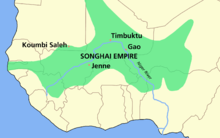Battle of Tondibi
This article includes a list of references, related reading, or external links, but its sources remain unclear because it lacks inline citations. (March 2013) |
| Battle of Tondibi | |||||||
|---|---|---|---|---|---|---|---|
 Songhai empire map | |||||||
| |||||||
| Belligerents | |||||||
|
| Songhai Empire | ||||||
| Commanders and leaders | |||||||
|
| Askia Ishaq II | ||||||
| Strength | |||||||
|
2,500 infantry equipped with Arquebus |
9,700 infantry | ||||||
| Casualties and losses | |||||||
| Unknown | Unknown but reportedly heavy losses | ||||||
The Battle of Tondibi was the decisive confrontation in the 16th-century invasion of the Songhai Empire by the army of the Saadi dynasty in Morocco. Though vastly outnumbered, the Moroccan forces under Judar Pasha defeated the Songhai Askia Ishaq II, guaranteeing the empire's downfall.
Background
The Songhai had been the dominant force in Western Africa for more than a century, controlling the Western Sudan from the headwaters of the Senegal River to what is now Niger; however, a succession fight after the 1583 death of Askia Daoud left the Empire in a weakened state.
Meanwhile, to the north, the Saadi Dynasty of Morocco was at the height of its power. In 1578, Morocco successfully repelled an attempt by Portugal to conquer it at the Battle of Alcácer Quibir, where its forces decimated a large Portuguese army.[citation needed] However, the expense of the defences they built used to hold off the Portuguese was a large strain on Morocco. The nation's coffers were depleted, and Morocco was on the verge of bankruptcy. In search of new resources for his kingdom, Sultan Ahmad I al-Mansur Saadi turned his attention to the Songhai Empire, where he erroneously believed had gold mines from which its wealth came.
Desert crossing
Though many of his advisors warned that it was illegal to wage war against another Muslim nation, Ahmad al-Mansur swept their objections aside. In October 1590, he dispatched a force of 1,500 light cavalry and 2,500 infantry, many of whom were equipped with arquebuses. The command he entrusted to Judar Pasha, a Spanish eunuch who had been captured as a child. The army travelled with a transport train of 8,000 camels, 1,000 packhorses, 1,000 stablemen, and 600 labourers; they also transported eight cannons.[citation needed]
After a four-month journey, Judar reached Songhai territory with his forces largely intact. His forces captured, plundered, and razed the salt mines at Taghaza. The Moroccans then advanced on the Songhai capital of Gao.[citation needed]
Battle
On 13 March 1591, the armies met.[1] From Taghaza, the Moroccan army marched towards Gao. The Songhai army awaited Judar's force near Tondibi, a cattle pasture just north of Gao. Though the Songhai had a powerful cavalry, they lacked the Moroccans' gunpowder weapons, which would turn the tide of the battle.[2]
The Songhai battle strategy was poorly thought out. They planned to send a stampede of 1,000 cattle to break down the Moroccan lines and to cover their infantry (who lacked gunpowder weapons) failed, with the cattle charge being repelled by the noise of gunfire and the sound of cannons, which caused the cattle to stampede back towards Songhai lines. The Songhai infantry continued to pursue the Moroccan army as planned but were slaughtered by Moroccan arquebuses. The Songhai cavalry then charged at the Moroccan lines. After an initial cavalry skirmish, Judar manoeuvred his arquebusiers into place and opened fire with both arquebuses and cannons. The remaining Songhai cavalry fled the field or were massacred by Moroccan gunfire. At last, only the rearguard remained, in hand-to-hand combat against the Moroccans, until they were killed.
Consequences
Judar Pasha continued onto Gao and sacked the city, whose residents had already evacuated,[3] but finding little in the way of riches soon moved on to the richer trading centers of Timbuktu and Djenné. The looting of the three cities marked the end of the Songhai Empire as an effective force in the region; however, Morocco proved likewise unable to assert firm control over the area due to the vastness of the Songhai Empire and difficulties of communication and resupply across the Saharan trade routes, and a decade of sporadic fighting began. The area eventually splintered into dozens of smaller kingdoms, and the Songhai themselves moved east to the only surviving province of Dendi and continued the Songhai tradition for the next two and a half centuries.
References
- ^ Kaba, Lansiné (1981). "Archers, Musketeers, and Mosquitoes: The Moroccan Invasion of the Sudan and the Songhay Resistance (1591-1612)". The Journal of African History. 22 (4): 457–475. doi:10.1017/S0021853700019861. ISSN 0021-8537. JSTOR 181298. PMID 11632225.
- ^ David, Saul (2012). The Illustrated Encyclopedia of Warfare: From Ancient Egypt to Iraq. Dorling Kindersley. p. 402. ISBN 978-1-4654-0373-5.
- ^ UNESCO General History of Africa, Vol. V., pg. 303
- Davidson, Basil (1995). Africa in History. New York: Simon & Schuster. ISBN 0-684-82667-4.
- Pennell, C. R. (2009). Morocco: From Empire to Independence (2nd ed.). London: Oneworld. ISBN 978-1-85168-634-6.
External links
